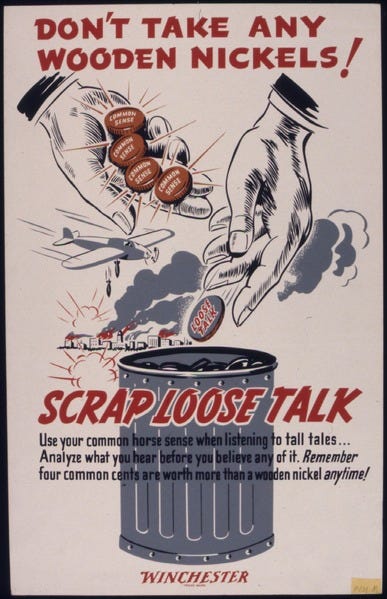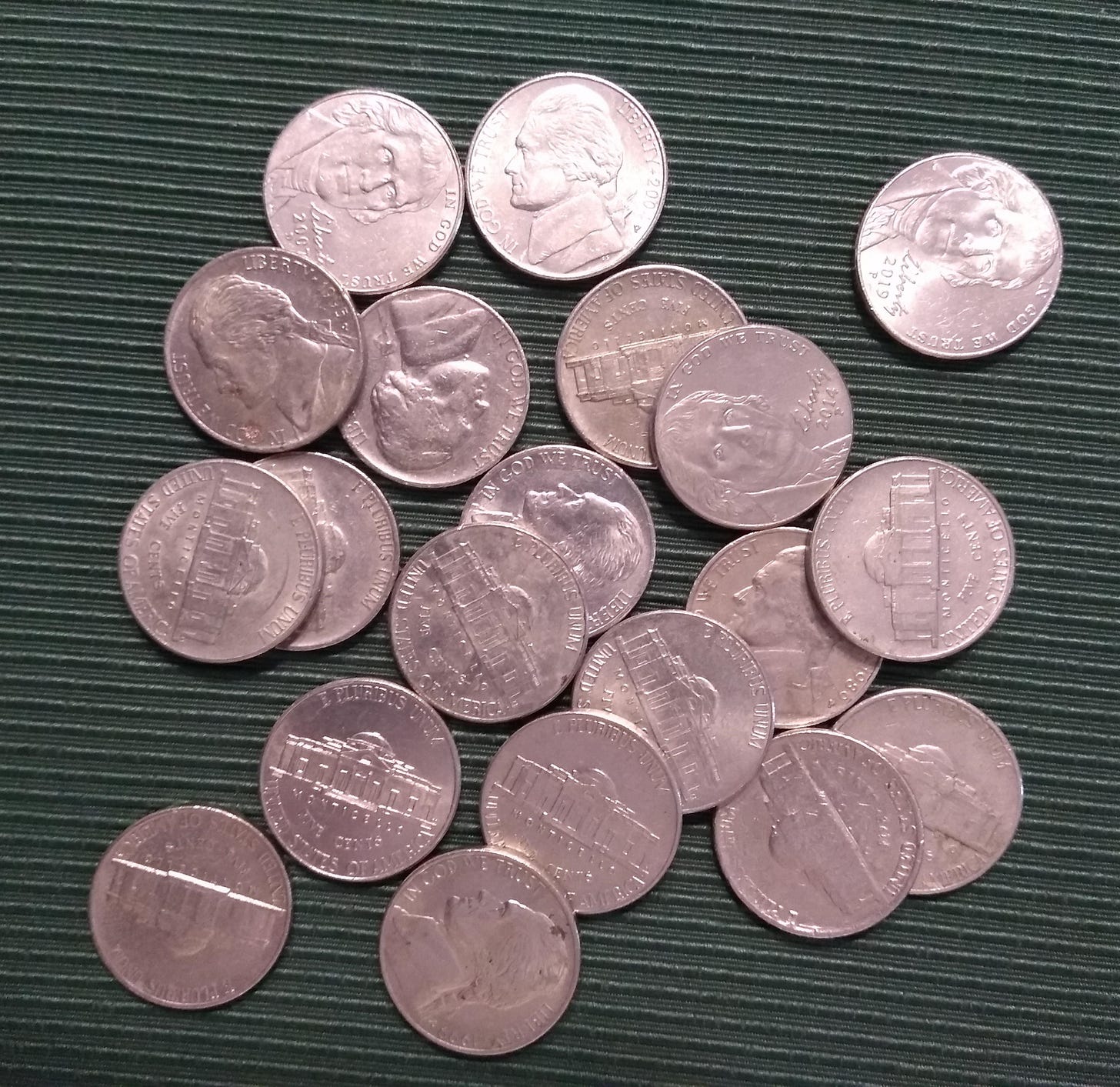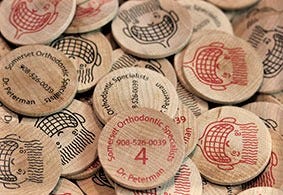As the world re-opens and global traveling is once more in the mix perhaps this caveat has some value still, “Don’t take any wooden nickels!”
In the early 1900’s, it was a humorous warning, made to rural or unsophisticated travelers to “the big cities.” A warning to beware of con men and city slickers.
The proverb may have roots in the 1800s when itinerant peddlers sold their wares from town to town. Some unscrupulous salesmen mixed wooden seeds and wooden nutmegs along with the actual seeds and nutmegs they sold. The warning then was “Don’t let anyone sell you a wooden nutmeg.”
The wooden nickel warning couldn’t have started until the late 1800’s. Nickels didn’t exist as U.S. coinage until then.
There were silver half-dimes, valued at five cents, minted from 1794-1873, but not nickels. “Nickel” was used to refer to other coins that weren’t valued at five cents. Initially, the Indian Head one-cent coin, made from 1859-1964, was referred to as a “nick” or nickel because it was made of a copper nickel alloy. Also, a copper alloy, three-cent “nickel” was produced from 1865-1889. The first five-cent nickel coins, as we know them, weren’t minted until 1866.
“Don’t take any wooden nickels” became popular in the early 20th century. In Ring Lardner’s 1919 novel, The Real Dope, soldier Jack Keefe writes in his letter of May 16, 1918 to the girl he hopes to see in Cologne:
We’ll girlie we will be out of here in less then a wk. now if we don’t have no bad luck and you can bet I won’t waist no time getting to where ever they send us and I hope its Cologne. So in the mean wile don’t take no wood nickles and don’t get impatient but be a good girlie and save up your loving for me. Tres beaucoup from
Your Sammy Boy, Jack Keefe
But who would believe that wooden nickels were real currency?
Actually, wooden money has been used in both Canada and the U.S. During the Depression, some towns were allowed to print wooden money or scrip.
The Citizens Bank of Tenino, Washington failed on December 5, 1931. The bank was placed in receivership and everyone’s accounts were frozen. Tenino’s Chamber of Commerce met to determine what could be done to enable local businesses to survive when townspeople had no access to their own money.
A plan was proposed by the secretary of the Chamber, Don Major, who also happened to be the publisher of the local newspaper. He proposed that Tenino Independent’s presses be used to print the town’s own money. Townspeople would assign 25% of their bank accounts in exchange for the value in the printed scrip. The local businesses would then accept the scrip and redeem the money to the Chamber once the bank liquidators released the funds.
The new currency was printed on paper stock at first and $1280 worth was distributed among the citizens. Eventually $1080 was redeemed. At the time, Don Major had been experimenting with a new type of stock known as “slice wood” to produce novelty Christmas cards. The wood stock was made from spruce and cedar and sliced to a thickness of 1/80 of an inch. In late December, the first Tenino wooden money was printed – a total of 40 twenty-five cent certificates. In February 1932, more wooden certificates of $1, $.50 and $.25 were printed.
The story of Tenino, WA printing its own wooden money, became national news. Collectors world-wide wrote asking for wooden money for their collections. The Chamber continued to print the unique currency through 1933. Of the $10,000 worth of the wooden money that was produced, less than $50 was redeemed. Most ended up in collections.
The concept of wooden money as scrip was picked up by other towns. According to a 1933 article in The Blaine Journal, when the bank in Blaine, Washington failed, the Chamber of Commerce began printing their own wooden coins. The City Council approved non-interest-bearing warrants as security for the coins and local businesses accepted the coins.
Interestingly enough, the town of Tenino printed wooden scrip once again during the pandemic to aid local business through the COVID 19 Grant Recovery program.
Soon, wooden money and nickels became popular as commemorative souvenirs. One of the first such souvenirs was distributed at the 1933 Chicago World’s Fair. Other wooden nickel souvenirs followed. Some got you a drink.
Nationally, the Wild Oats Markets promotes a store-wide Wooden Nickels campaign to support local communities. Wild Oats is a natural foods company started in Boulder, CO in 1987. It is one of the largest natural and organic foods supermarket chains in the nation.

In addition to Wild Oats’ pledge to provide the best selection of natural foods and health care products, the company supports local community non-profits. They also encourage recycling and reusing grocery bags through their Wooden Nickel program. When customers provide their own bags, they receive either a 5-cent refund on their bill or a wooden nickel for each bag. The customers can then choose which local non-profits to donate to by placing the wooden nickels in local charity boxes in the store.
Perhaps the most inventive idea for wooden nickels is the incentive program offered by an orthodontist in New Jersey. Patients can earn wooden nickels for a variety of things such as being on time for appointments, wearing their rubber bands, and excellent oral hygiene. The wooden nickels can be cashed in for gift cards good at Dunkin’ Donuts, Wendy’s, ITunes, Amazon, and Kohl’s, among others.
Interested in having wooden nickels made for a special event or a business? The Old-Time Wooden Nickel Company in San Antonio, Texas has been producing wooden nickels for over 70 years, making it the oldest wooden nickel manufacturing company in the nation. The Old Time Wooden Nickel Company museum has over 4,000 unique designs of custom wooden nickels. The company museum possesses the largest wooden nickel in the world, as recognized by Ripley’s Believe It or Not. The nickel is 13 feet and 4 inches, 5.5 inches thick, and weighs over 2,500 pounds.
Thank you for reading! Please share your comments, pictures, or memories. I’d love to hear your stories. Please comment below or email me at mhelmers@andoverhistoryandculture.org
And remember to watch out for wooden nickels!
Resources
Andover Center for History and Culture Collections
Wooden Nickels and the Great Depression
Smithsonian Magazine History of Nickel










